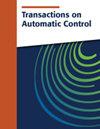Securing Mobile Robotic Networks Against Replacement Attack
IF 7
1区 计算机科学
Q1 AUTOMATION & CONTROL SYSTEMS
引用次数: 0
Abstract
The security of mobile robotic networks (MRNs) has been an active research topic in recent years. This article aims to secure the ubiquitous formation control of MRNs against the replacement attack, where an external robot can replace a formation robot by compromising the communication and physically interfering with the victim simultaneously. To counter this advanced attack, the novel idea of this work is to leverage the physical proximity of the formation shape and the interaction topology among robots for defense design. First, from the physical proximity perspective, we propose the convex neighbor polygon (CNP) to capture the geometric characteristic of the formation robots, and design a CNP-based security mechanism for the robots during the replacement attack. Then, from the interaction perspective, we introduce the indirect controllability to characterize the possibility that the attacker leverages the interaction between robots to deactivate the CNP mechanism, and establish the conditions regarding the topology structure and the attack input to counter the replacement. Finally, based on the obtained conditions, we demonstrate how to design the initiatory topology among the formation robots to enhance the defense performance. Comparative simulations verify the effectiveness of the proposed method.保护移动机器人网络免受替代攻击
近年来,移动机器人网络(MRNs)的安全性一直是一个活跃的研究课题。本文旨在确保mrn无处不在的编队控制免受替代攻击,其中外部机器人可以通过破坏通信并同时对受害者进行物理干扰来取代编队机器人。为了对抗这种先进的攻击,这项工作的新思想是利用编队形状的物理接近性和机器人之间的相互作用拓扑进行防御设计。首先,从物理接近的角度出发,提出了凸邻多边形(CNP)来捕捉编队机器人的几何特征,并设计了一种基于凸邻多边形的替代攻击安全机制。然后,从交互的角度,引入间接可控性来表征攻击者利用机器人之间的交互来破坏CNP机制的可能性,并建立了拓扑结构和攻击输入的条件来对抗替换。最后,基于所获得的条件,演示了如何设计编队机器人之间的初始拓扑以提高防御性能。仿真对比验证了该方法的有效性。
本文章由计算机程序翻译,如有差异,请以英文原文为准。
求助全文
约1分钟内获得全文
求助全文
来源期刊

IEEE Transactions on Automatic Control
工程技术-工程:电子与电气
CiteScore
11.30
自引率
5.90%
发文量
824
审稿时长
9 months
期刊介绍:
In the IEEE Transactions on Automatic Control, the IEEE Control Systems Society publishes high-quality papers on the theory, design, and applications of control engineering. Two types of contributions are regularly considered:
1) Papers: Presentation of significant research, development, or application of control concepts.
2) Technical Notes and Correspondence: Brief technical notes, comments on published areas or established control topics, corrections to papers and notes published in the Transactions.
In addition, special papers (tutorials, surveys, and perspectives on the theory and applications of control systems topics) are solicited.
 求助内容:
求助内容: 应助结果提醒方式:
应助结果提醒方式:


